This stuffed bitter melon soup is a delicious Vietnamese “soup”, stuffed with pork, mushroom, and mung bean noodles, simmered until the melon softens in a light chicken broth.
As a kid, my parents couldn’t get me to eat this stuff, but I’ve really grown to love this dish.
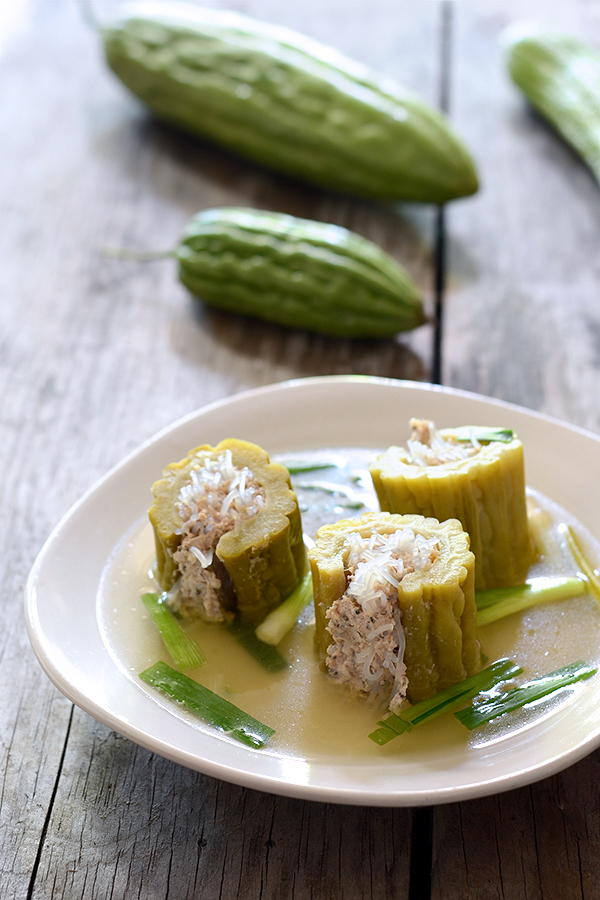
This dish is typically a heck yes, or heck no situation for most people. But I urge if if ever given the chance, to at least try it. Yes the bitterness can be a ride with some bites, but this flavor has grown on me!
An acquired taste?
They say you start to like bitter foods as you get older and this seems to be true for me. Along with beer, coffee, and many raw veggies, canh khổ qua is something I actually enjoy which I did not ~10 years ago.
Pour-over black coffee is something I’m nuts about right now (currently awaiting a package of Stumptown beans!), with the occasional Vietnamese iced coffee. I’m sure you eat a bunch of food now that you wouldn’t touch years back, right?
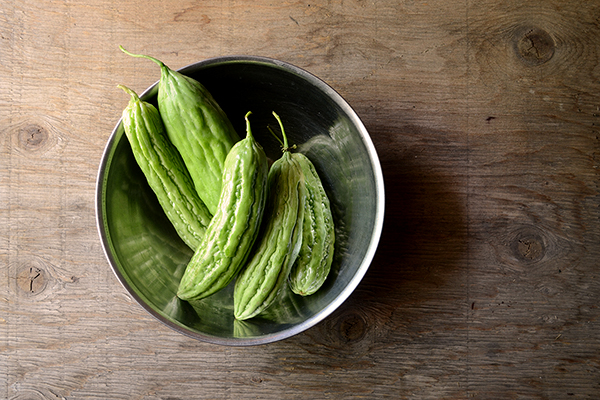
Besides, these bitter melons are stuffed with meat and simmered in a tasty soup, which balances the strong bitter taste out quite nicely.
Bitter melon, strange name
“Khổ qua” is the name of this melon in Vietnamese and roughly means “difficulty/hardship passed.” Most of my relatives who grew up in Vietnam have no idea why it’s called that, and were surprised I even asked since obviously it’s just the name of the plant.
Turns out, this is a plant originating from Africa, but has been used for centuries in Chinese folk medicine (wiki link to momordica charantia) folk medicine. Hong and Kim, from The Ravenous Couple, actually pointed out that in Chinese Mandarin, bitter melon is “ku gua.”
Seeing khổ qua as an adaptation of ku gua is very likely, given the Vietnamese language was influenced a lot by China and shares a lot of vocabulary. I’m getting sporadic vocabulary lessons from my grandma, and she often tells me the word in question is a Han word!
It’s most commonly called bitter melon, or bitter gourd though for the rest of us!
Where To Buy Bitter Melon
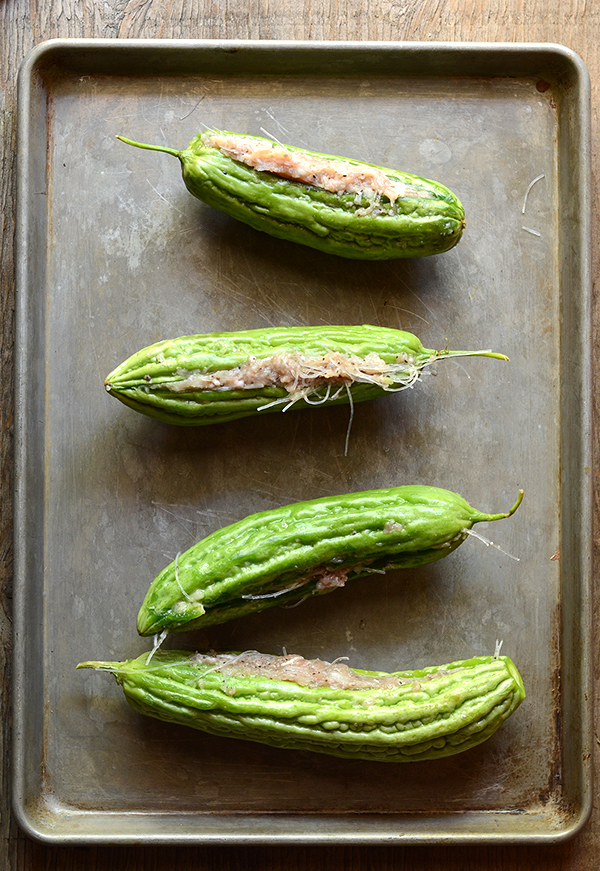
Where can you find these bitter treats we call bitter melon? They’re common to Chinese, Indian, and many other Asian cuisines, so your best bet is to hit up a local Asian supermarket! I don’t recall seeing this melon sold at any American mega-marts.
The type you’ll use in this recipe is actually the Chinese variety. It’s rounder at the ends and smoother looking than the pointed, Indian variety. In my experience some seem to be bitter than others, and it’s really a toss-up. I’d love to hear any tips you have on choosing good bitter melons in the comments below!
What’s your verdict?

So what are your thoughts on bitter melon, heck yes or heck no? Maybe you like it prepared in another way? Let me know in the comments below!
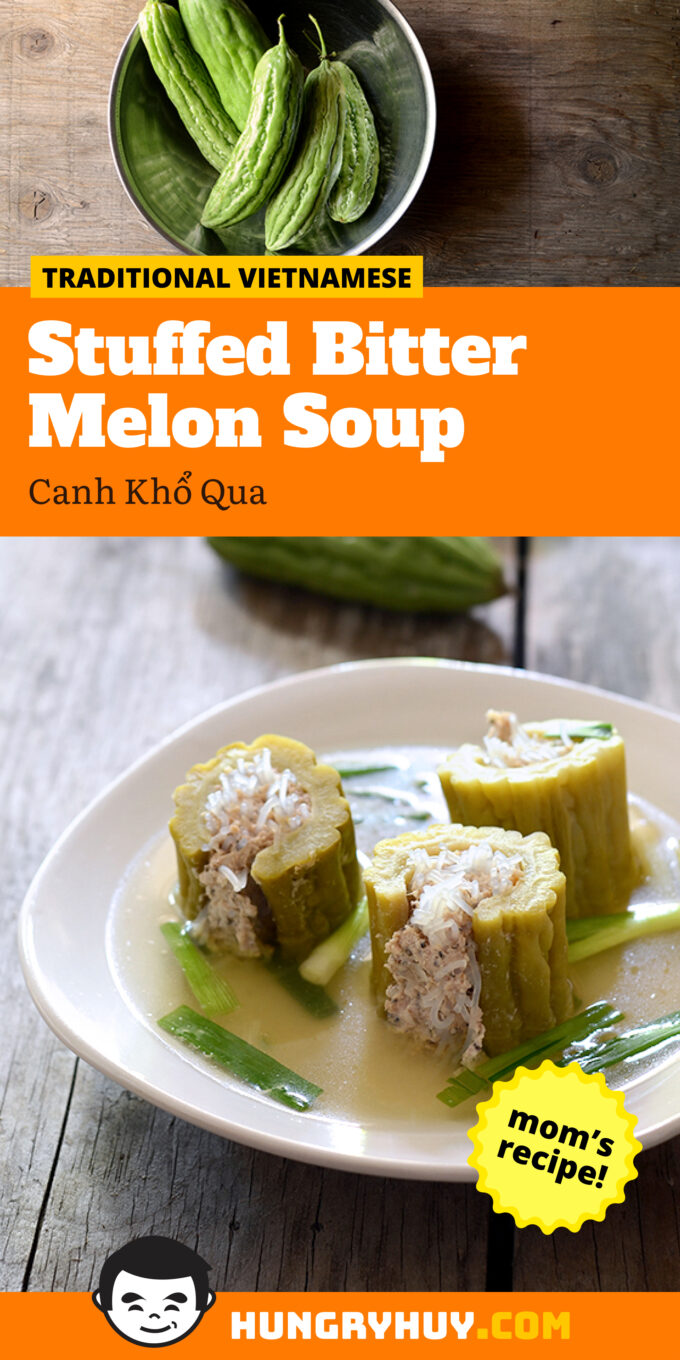
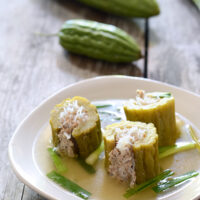
Stuffed Bitter Melon Soup (Canh Khổ Qua)
Ingredients
- 4 bitter melons 5-6″ long or 3 bitter melons 8″ long
Filling
- 1 lb ground pork
- 1 medium onion ~2/3 cup chopped
- 1/2 cup hydrated wood ear mushrooms chopped (pictured on my egg roll recipe)
- 1 pack of dried mung bean noodles chopped. ~1 cup hydrated. (also pictured on my egg roll recipe)
- 2 teaspoon sugar
- 1 teaspoon salt
- 1 teaspoon pepper
- 1/2 tablespoon fish sauce optional
Broth
- 3 cups broth
- 4.5 cups water
- sugar and salt for seasoning the broth
Garnish
- cilantro chopped
- green onions chopped
Instructions
- Soak bean threads in hot tap water and mushrooms in 40-second microwaved hot tap water until soft. About 10 minutes. Drain and rinse mushrooms well.
- Cut a slit along each bitter melon and remove the seeds with a spoon. Sometimes it just wont open properly so you’ll need to split the melon in half lengthwise and just add the filling.
- Bring the water and broth to a boil in a pot on high heat, but put aside about 1 cup for adjusting seasoning.
- Add the stuffed bitter melons
- Turn heat down to reach a low boil, simmer for 20-30 minutes until bitter melons are fork-tender.
- The water will have slightly evaporated and the stuffing released seasoning to the broth, so taste it then add salt and sugar to your liking if needed, or add more hot water to dilute it.
- Remove bitter melons and cut into 1.5-2″ long pieces.
- Garnish with cilantro and green onion, serve with broth.




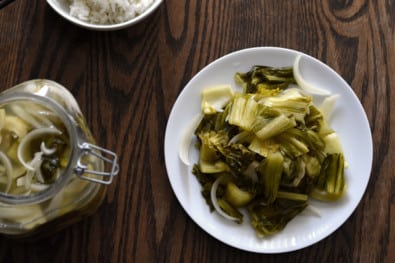





Hi Huy!
I love your food blog. It’s very personal, cultural, and enjoyable to read. I am Hmong and my mom have made the Stuffed Bitter Melon Soup (Canh Khổ Qua) dish for us before. I would recommend putting lemon grass in the broth. It adds more flavor to the entire dish. Another dish my mom has made for the family is chicken or squirrel boiled in a lemon grass broth with sliced bitter melon. It’s very refreshing and healthy. I agree with you that it is an acquired taste. It was a “heck no” for me 10 years ago as well! Anywho, keep up the good work Huy!
Jewel Y.
Hey Jewel!
Thanks for writing! glad you enjoy the blog–you are very kind! I have really no idea about Hmong food but your recommendations are interesting–will keep in mind the lemongrass tip for next time! A lot of my acquired tastes dominate my food habits now, so definitely encourage everyone to try new stuff. Come back again, ya hear? 🙂
you are correct in “khổ qua as an adaptation of ku gua” but “Khổ qua” is not “roughly means “difficulty/hardship passed” in Vietnamese. I am laughing hard at the moment (not at you though!) because i made the same mistake when i was 11yrs old.. 🙂 And, i loved this dish since I was at that age. I used to cook this dish since I was around 7yrs old. Funny thing is I now dislike it at 40 b/c I can’t get fresh melons nor fresh pork (i meant pork that has never been through a frozen and thaw process) to make it now in north america… Anyway, “qua” is written in Han tu like this “瓜” which generally refers to fruits on vines. And, “khổ” means bitter. So, yes… Khổ qua is “Mướp đắng” or bitter melon. Why it is “Mướp” but not “bầu” or “bí” is another dish to hash over lots of beers. Cheers! Dinh
Hi Dinh! Yeah “khổ qua” doesn’t make sense translated into English as that phrase since–it just happens to sound like it. It’s funny to me because eating such a bitter food is quite the hardship for some :).
I can only only much better it tastes with all fresher ingredients like you mentioned. Once you have it the ‘right’ way I bet its hard to go back, hm? Thanks for your insight here, it’s appreciated!
I have a bunch of the Indian ones in my fridge right now. I’ve read that they are good for normalizing blood sugar, too. Years ago I attempted to add bitter melon to a stir fry and my husband accused me of trying to kill him (and I am a fantastic cook, really!) It is an acquired taste. Just for kicks I juice it with carrots and apples and it really takes the bitter edge off.
LOL Beth! Folks act like bitter melon wasn’t meat to be food :). Drinking it raw without mixing is a super-acquired taste I think! Thanks for the tip too–are the Indian ones good for juicing or are you using those for something else?
One of my favorite dishes my Dad makes!!
Hi Amanda, yeah it’s a good soup! Not as easy for most to eat as your Ginjas tho 🙂
I’m the same way. Never could eat this growing up, toooo bitter. But now that I’m in my 40’s, I beg my Ma to make it almost as often as I beg her to make banh xeo (my favorite).
Hey Wanda isn’t it funny how tastes change so much? When you don’t feel like beggin Ma, you can easily try this out for yourself! 🙂
I see that you have the recipes for the stuffed pork with bitter melon. I was wondering if you have a nutritional fact on it? I am doing this diabetes class and we’re talking about what benefits that the bitter melon have for them. If you have the nutritional facts on it. I would love get it from you and talk to all these people about it. Thank you!
I’ve loved bitter melon for years. I like it fried and paired with rice and kimchi, or scrambled eggs.
In Chinese Khu Gua literally means, bitter melon. The word Khu can mean both bitter (the taste) or hardship (emotion). Gua is a Melon. Here, it is talking about the taste. But in fact, to say one experienced hardship is actually the say, Chi Gu, or to eat hardship, or to eat bitterness. Chinese people love these double entrendres, so it’s really a clever name. Excuse me if my pinyin is wrong.
Belinda, I love the insight and excited to know there are many other Chinese double entendres to be discovered. Thanks for sharing!
Hi Huy!
Just moved pretty far from my parents and can’t just go home when I miss my mum’s cooking. Your blog has been a god-sent, this was the recipe that made me follow you for other stuff too. Tasted exactly like how my mum makes it! Love from Japan, Cathy
I made this today and it’s just like how my mom used to make it. I paired it with fried tofu, delicious!